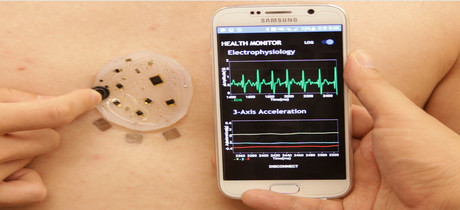Electronic skin: the future of biosensors

There has recently been a growing interest in soft electronics which are designed to intimately interface with the soft tissues of the human body, such as skin. Now, an international research team has created a soft sensor microsystem with a 3D design, bypassing the limitations of traditional 2D designs and making it suitable for applications such as continuous health monitoring and disease treatment.
The microsystem contains a variety of sensors connected by a network of tiny wire coils, all placed in a soft silicone pad about 4 cm in diameter. The elastic silicone base is stretched while the tiny wire arcs, made of gold, chromium and phosphate, are laid onto it. The arcs are firmly connected to the base only at one end of each arc. When the base is allowed to contract, the arcs pop up, forming 3D coils that connect the system’s sensors, circuits and radios to each other.
The entire system is encased in a soft silicone material to protect its components, and is powered wirelessly rather than being charged by a battery. The platform enables wireless collection, analysis and storage of biosignal data performing as a separate computer.

The team used the system to build and test a biomonitor that can be easily attached to the skin. It contained about 50 components connected by 250 individual microcoils and wirelessly transmitted data on movement and respiration, as well as electrical activity in the heart, muscles, eyes and brain, to a smartphone application.
While conventional flat sensors are not suitable for the human skin, the coils are much more flexible than wires laid flat into a sensor; flexibility is critical for application on soft tissue. The coils and components are configured in an unusual spider web pattern that ensures “uniform and extreme levels of stretchability and bendability in any direction”, according to the researchers, as well as minimising the system’s size. The researchers also considered key electrical and mechanical issues to optimise the system’s physical layout, such as sensor placement or wire length, to minimise signal interference and noise.
The microsystem is described in detail in the journal Nature Communications. The researchers noted it could be used in other areas of emerging interest in addition to bio-integrated electronics, such as soft robotics or autonomous navigation.
Handheld sensor enables rapid detection of multiple bacteria
Researchers have developed a handheld biosensor that can simultaneously detect multiple...
'Frozen smoke' sensors detect indoor pollutants
Researchers have developed a sensor made from 'frozen smoke' that uses artificial...
New sweat-resistant wearable robot sensor
Researchers have developed an electromyography (EMG) sensor technology that is unaffected by the...










